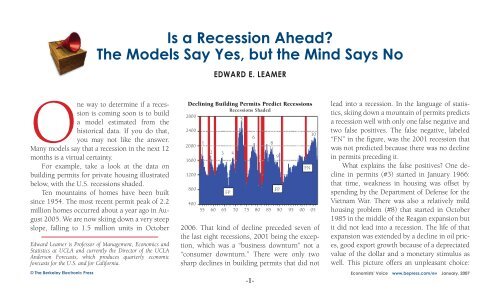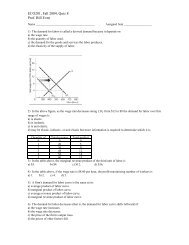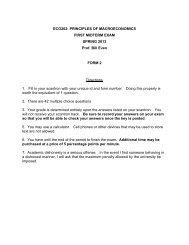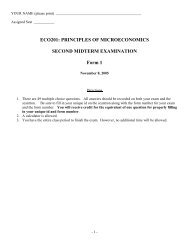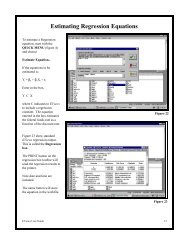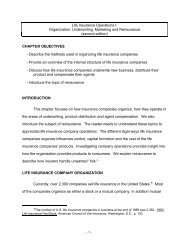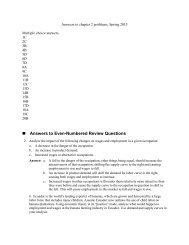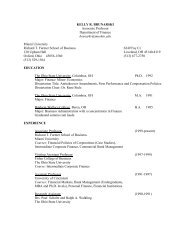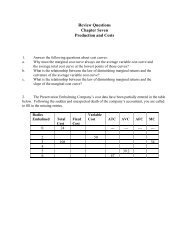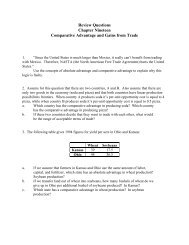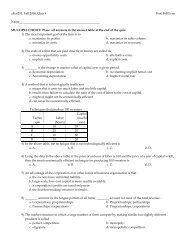Is a Recession Ahead? The Models Say Yes, but the Mind Says No
Is a Recession Ahead? The Models Say Yes, but the Mind Says No
Is a Recession Ahead? The Models Say Yes, but the Mind Says No
Create successful ePaper yourself
Turn your PDF publications into a flip-book with our unique Google optimized e-Paper software.
<strong>Is</strong> a <strong>Recession</strong> <strong>Ahead</strong><br />
<strong>The</strong> <strong>Models</strong> <strong>Say</strong> <strong>Yes</strong>, <strong>but</strong> <strong>the</strong> <strong>Mind</strong> <strong>Say</strong>s <strong>No</strong><br />
Edward E. Leamer<br />
One way to determine if a recession<br />
is coming soon is to build<br />
a model estimated from <strong>the</strong><br />
historical data. If you do that,<br />
you may not like <strong>the</strong> answer.<br />
Many models say that a recession in <strong>the</strong> next 12<br />
months is a virtual certainty.<br />
For example, take a look at <strong>the</strong> data on<br />
building permits for private housing illustrated<br />
below, with <strong>the</strong> U.S. recessions shaded.<br />
Ten mountains of homes have been built<br />
since 1954. <strong>The</strong> most recent permit peak of 2.2<br />
million homes occurred about a year ago in August<br />
2005. We are now skiing down a very steep<br />
slope, falling to 1.5 million units in October<br />
Edward Leamer is Professor of Management, Economics and<br />
Statistics at UCLA and currently <strong>the</strong> Director of <strong>the</strong> UCLA<br />
Anderson Forecasts, which produces quarterly economic<br />
forecasts for <strong>the</strong> U.S. and for California.<br />
© <strong>The</strong> Berkeley Electronic Press<br />
Declining Building Permits Predict <strong>Recession</strong>s<br />
<strong>Recession</strong>s Shaded<br />
2800<br />
5<br />
2400<br />
2000<br />
1600<br />
1200<br />
800<br />
1<br />
2<br />
3<br />
FP<br />
4<br />
400<br />
55 60 65 70 75 80 85 90 95 00 05<br />
2006. That kind of decline preceded seven of<br />
<strong>the</strong> last eight recessions, 2001 being <strong>the</strong> exception,<br />
which was a “business downturn” not a<br />
“consumer downturn.” <strong>The</strong>re were only two<br />
sharp declines in building permits that did not<br />
6<br />
--<br />
7<br />
8<br />
9<br />
FP<br />
FN<br />
10<br />
lead into a recession. In <strong>the</strong> language of statistics,<br />
skiing down a mountain of permits predicts<br />
a recession well with only one false negative and<br />
two false positives. <strong>The</strong> false negative, labeled<br />
“FN” in <strong>the</strong> figure, was <strong>the</strong> 2001 recession that<br />
was not predicted because <strong>the</strong>re was no decline<br />
in permits preceding it.<br />
What explains <strong>the</strong> false positives One decline<br />
in permits (#3) started in January 1966:<br />
that time, weakness in housing was offset by<br />
spending by <strong>the</strong> Department of Defense for <strong>the</strong><br />
Vietnam War. <strong>The</strong>re was also a relatively mild<br />
housing problem (#8) that started in October<br />
1985 in <strong>the</strong> middle of <strong>the</strong> Reagan expansion <strong>but</strong><br />
it did not lead into a recession. <strong>The</strong> life of that<br />
expansion was extended by a decline in oil prices,<br />
good export growth because of a depreciated<br />
value of <strong>the</strong> dollar and a monetary stimulus as<br />
well. This picture offers an unpleasant choice:<br />
Economists’ Voice www.bepress.com/ev January, 2007
a recession soon, or a huge ramp-up in spending<br />
on <strong>the</strong> war on terror, or some major good<br />
fortune.<br />
Any model built on housing starts is sure to<br />
say a recession is coming soon. But, <strong>the</strong> curmudgeon<br />
jokes: “Economists are like artists. <strong>The</strong>y<br />
tend to fall in love with <strong>the</strong>ir models.” With considerably<br />
less pleasure, I would add.<br />
Better to treat <strong>the</strong> model as a helpful companion,<br />
not an all-wise Delphic love-object. After<br />
all, accurate forecasting comes first from understanding<br />
that some things repeat and o<strong>the</strong>rs do<br />
not, and second from recognizing that <strong>the</strong> line<br />
between <strong>the</strong> two is constantly changing. <strong>Models</strong><br />
don’t have access to that bit of wisdom, since<br />
<strong>the</strong>y are necessarily built on <strong>the</strong> assumption<br />
that everything in <strong>the</strong>m only repeats. Electronic<br />
computers mindlessly project <strong>the</strong> past into <strong>the</strong><br />
future. <strong>The</strong> organic computer that sits on your<br />
shoulders doesn’t suffer from that psychological<br />
rigidity. Your brain is capable of a broad range of<br />
free-spirited thinking ranging from <strong>the</strong> insightful<br />
to <strong>the</strong> merely wishful.<br />
Thus, when your mind tells you that your<br />
model is going astray, listen carefully. Eliminate<br />
<strong>the</strong> wishful thinking and all that remains are <strong>the</strong><br />
insights.<br />
My view, announced in December<br />
2005, is that this time<br />
will be different. This time <strong>the</strong><br />
problems in housing will stay<br />
in housing. So far, I am feeling<br />
very smug. But this keeps me<br />
up at night.<br />
In this column, first <strong>the</strong><br />
models, and <strong>the</strong>n <strong>the</strong> mind.<br />
<strong>The</strong> models say that a recession<br />
is coming soon. <strong>The</strong> mind says<br />
o<strong>the</strong>rwise.<br />
<strong>the</strong> models: probit recession<br />
alarms<br />
<strong>The</strong> ten components of <strong>the</strong><br />
Conference Board Index of<br />
Leading Indicators are natural<br />
places to begin to make a model<br />
to predict <strong>the</strong> next recession.<br />
Table 1 reports <strong>the</strong>se ten components. To be<br />
evocative, I have sorted <strong>the</strong>m into groups: labor<br />
market, housing market, financial markets,<br />
manufacturing order books, and man-on-<strong>the</strong>street<br />
predictions.<br />
That “man-on-<strong>the</strong>-street” label for <strong>the</strong> “index<br />
of consumer expectations” is intended to be<br />
Table 1<br />
Components of Conference Board Index of Leading Indicators and Weight<br />
Leading Index<br />
Labor Market<br />
Conference<br />
Board Weights<br />
1. Average weekly hours, manufacturing 0.1963<br />
2. Average weekly initial claims for unemployment insurance 0.0255<br />
Housing Market<br />
3. Building permits, new private housing units 0.0205<br />
Financial Markets<br />
4. Interest rate spread, 10-year Treasury bonds less federal funds 0.3295<br />
5. Stock prices, 500 common stocks 0.0291<br />
6. Money supply, M2 0.2778<br />
Manufacturing Order Books<br />
7. Manufacturers’ new orders, consumer goods and materials 0.0587<br />
8. Manufacturers’ new orders, non-defense capital goods 0.0149<br />
9. Vendor performance, slower deliveries diffusion index 0.0293<br />
Man-on-<strong>the</strong>-street Predictions<br />
10. Index of consumer expectations 0.0185<br />
derogatory since, before looking at <strong>the</strong> data, we<br />
should begin with a high state of skepticism regarding<br />
<strong>the</strong> predictive value of survey responses<br />
to questions about <strong>the</strong> future state of <strong>the</strong> economy.<br />
What do <strong>the</strong>y know anyway<br />
I have estimated thirteen different equations<br />
that predict recessions using one of thirteen<br />
--<br />
Economists’ Voice www.bepress.com/ev January, 2007
different indicators: <strong>the</strong> ten components of <strong>the</strong><br />
Conference Board Index, <strong>the</strong> Purchasing Managers<br />
Index, <strong>the</strong> unemployment rate and <strong>the</strong><br />
real price of crude oil. Essentially, I ask with this<br />
analysis how <strong>the</strong> year before a recession is different<br />
from <strong>the</strong> o<strong>the</strong>r periods. I exclude from <strong>the</strong><br />
analysis <strong>the</strong> data during recessions as well as <strong>the</strong><br />
first two years of expansions. This eliminates <strong>the</strong><br />
recessions and <strong>the</strong> recovery periods that have<br />
<strong>the</strong>ir own special features which are not relevant<br />
to decide if a recession is coming soon.<br />
<strong>The</strong> best single variable for predicting recessions<br />
is <strong>the</strong> interest rate spread, followed by<br />
claims for unemployment and building permits.<br />
Consumer confidence is about in <strong>the</strong> middle of<br />
<strong>the</strong> pack, better than expected.<br />
<strong>The</strong>se various indicators provide ra<strong>the</strong>r different<br />
estimates of <strong>the</strong> probability of a recession<br />
in 12 months. <strong>The</strong> interest rate spread and<br />
building permits have <strong>the</strong> recession probability<br />
elevating substantially to 50 percent and 73<br />
percent respectively. All <strong>the</strong> o<strong>the</strong>r indicators are<br />
suggesting that <strong>the</strong> probability is very low. Two<br />
say likely, eleven say unlikely. Does that mean<br />
that <strong>the</strong> components toge<strong>the</strong>r suggest that a recession<br />
is unlikely<br />
<strong>No</strong>t really. <strong>The</strong> right way to combine <strong>the</strong><br />
leading indicators is not just to “mush” <strong>the</strong> results,<br />
<strong>the</strong> way <strong>the</strong> Conference Board does with<br />
<strong>the</strong> statistically irrelevant weights reported in<br />
Table 1—that method ignores altoge<strong>the</strong>r both<br />
<strong>the</strong> relative accuracy and <strong>the</strong> major differences<br />
in timing of <strong>the</strong> components. For example, with<br />
regards to timing, an inverted yield curve in <strong>the</strong><br />
last six months signals an oncoming recession,<br />
while it is a fall in building permits over <strong>the</strong> last<br />
18 months that matters.<br />
Instead of “mushing” <strong>the</strong> models, I consider<br />
<strong>the</strong> 1760 models involving three of <strong>the</strong>se thirteen<br />
indicators in all different combinations. <strong>The</strong><br />
model that fits <strong>the</strong> data best predicts recessions<br />
from (1) <strong>the</strong> interest rate spread, (2) building<br />
permits, and (3) <strong>the</strong> unemployment rate. According<br />
to this model, <strong>the</strong> probability of a recession<br />
in one year rose to 86 percent in January<br />
2006 and to 100 percent in March 2006, and<br />
has been stuck at 100 percent through October<br />
2006. According to this (imperfect) predictive<br />
probability, a recession is a virtual certainty and<br />
likely to commence in <strong>the</strong> first quarter of 2007.<br />
Many of <strong>the</strong> o<strong>the</strong>r 1759 models have lower probabilities<br />
of recession, <strong>but</strong> <strong>the</strong>se are so inferior<br />
that a weighted forecast is essentially <strong>the</strong> same<br />
as <strong>the</strong> forecast of <strong>the</strong> best model.<br />
<strong>the</strong> mind:<br />
T<br />
why i think <strong>the</strong> models are wrong<br />
he models that rely on history suggest that<br />
<strong>the</strong> extreme problems in housing currently<br />
being corrected will almost surely infect <strong>the</strong><br />
rest of <strong>the</strong> economy, <strong>but</strong> that history does not<br />
take into account two important facts:<br />
• Manufacturing is not poised to contri<strong>but</strong>e<br />
much to job loss.<br />
• Real interest rates are very low and <strong>the</strong>re is no<br />
evident credit crunch, now or on <strong>the</strong> horizon.<br />
<strong>The</strong>se facts make <strong>the</strong> problem in housing<br />
less severe than it would be o<strong>the</strong>rwise, and help<br />
to confine <strong>the</strong> pathology to <strong>the</strong> directly affected<br />
real estate sectors: builders, real estate brokers<br />
and real estate bankers.<br />
You can see <strong>the</strong> manufacturing point in three<br />
figures (see next page):<br />
• Outside of manufacturing and construction,<br />
<strong>the</strong>re is hardly any job loss, as illustrated in<br />
Figure 1.<br />
--<br />
Economists’ Voice www.bepress.com/ev January, 2007
200000<br />
100000<br />
80000<br />
60000<br />
50000<br />
40000<br />
30000<br />
20000<br />
Figure 1—Payrolls Jobs<br />
Figure 2—Detrended Employment in<br />
Manufacturing and Construction<br />
(Manufacturing has one trend before 1983 and ano<strong>the</strong>r after)<br />
2000<br />
1000<br />
0<br />
-1000<br />
Figure 3— Contri<strong>but</strong>ions to Job Loss<br />
from Manufacturing and Construction<br />
Year over Year Changes in Employment as a Percentage<br />
of Jobs Outside Manufacturing and Construction<br />
.08<br />
.06<br />
.04<br />
.02<br />
.00<br />
10000<br />
40 45 50 55 60 65 70 75 80 85 90 95 00 05<br />
TOTAL-CONSTRUCTION-MANUFACTURING<br />
20000<br />
16000<br />
Employment in Manufacturing and Construction<br />
10000<br />
Construction (Right Scale)<br />
5000<br />
3000<br />
2000<br />
1500<br />
1000<br />
-2000<br />
-3000<br />
50 55 60 65 70 75 80 85 90 95 00 05<br />
-.02<br />
-.04<br />
-.06<br />
50 55 60 65 70 75 80 85 90 95 00 05<br />
CONSTRUCTION-CONSTRUC_TREND<br />
MANUFACTURING-MANUF_TREND (CONSTRUCTION-CONSTRUCTION(-12))/<br />
TOTAL_OTHER(-12)<br />
(MANUFACTURING-MANUFACTURING(-12))/<br />
TOTAL_OTHER(-12)<br />
12000<br />
Manufacturing (Left Scale)<br />
500<br />
8000<br />
40 45 50 55 60 65 70 75 80 85 90 95 00 05<br />
--<br />
Economists’ Voice www.bepress.com/ev January, 2007
• <strong>The</strong> employment cycles in construction and<br />
manufacturing are normally closely coordinated<br />
<strong>but</strong> <strong>the</strong>y disconnected in <strong>the</strong> 2001<br />
downturn, as shown in Figure 2. While<br />
construction is at a peak, manufacturing is<br />
at a trough, having never recovered from<br />
<strong>the</strong> last recession.<br />
• <strong>The</strong>re cannot be enough job loss in construction<br />
alone to qualify as a real recession.<br />
See Figure 3.<br />
<strong>The</strong> bad news is that we trimmed 3 million<br />
jobs from manufacturing in <strong>the</strong> 2001 recession,<br />
<strong>but</strong> <strong>the</strong> good news is <strong>the</strong>re aren’t many more<br />
to lose. That makes a recession highly unlikely,<br />
even though analysis of <strong>the</strong> historical data suggests<br />
o<strong>the</strong>rwise. But that analysis cannot deal<br />
with <strong>the</strong> current disconnect between <strong>the</strong> construction<br />
and manufacturing cycles, because it<br />
hasn’t happened before.<br />
conclusion<br />
<strong>The</strong> models say “recession;” <strong>the</strong> mind says<br />
“no way.”<br />
I’m going with <strong>the</strong> mind. This time <strong>the</strong><br />
problems in housing will stay in housing. If you<br />
are a builder or a broker, it will feel like a deep<br />
depression. <strong>The</strong> rest of us will hardly notice.<br />
Letters commenting on this piece or o<strong>the</strong>rs may<br />
be submitted at http://www.bepress.com/cgi/<br />
submit.cgicontext=ev.<br />
references and fur<strong>the</strong>r reading<br />
Keilis-Borok1, V. I., Solovie, A. A., Allègre,<br />
C. B., Sobolevskii, A. N., Intriligator, M. D.,<br />
Winberg, F. E. (2006) “Prediction of <strong>the</strong> Rise of<br />
Unemployment in <strong>the</strong> U.S.,” UCLA Forecast,<br />
www.uclaforecast.com.<br />
Leamer, Edward E. (2006) “<strong>Models</strong> or <strong>Mind</strong>s”<br />
UCLA Forecast, www.uclaforecast.com.<br />
Leamer, Edward E. (2005) “Conference Board’s<br />
Index of Leading Indicators,” UCLA Forecast,<br />
www.uclaforecast.com.<br />
Leamer, Edward E. (2005) “<strong>No</strong> <strong>Recession</strong> Any<br />
Time Soon, But Troubles <strong>Ahead</strong>, <strong>No</strong>ne<strong>the</strong>less,”<br />
UCLA Forecast, www.uclaforecast.com.<br />
Leamer, Edward E. (2001) “<strong>The</strong> Life Cycle of<br />
US Economic Expansions,” NBER Working Paper<br />
<strong>No</strong>. 8192.<br />
--<br />
Economists’ Voice www.bepress.com/ev January, 2007


